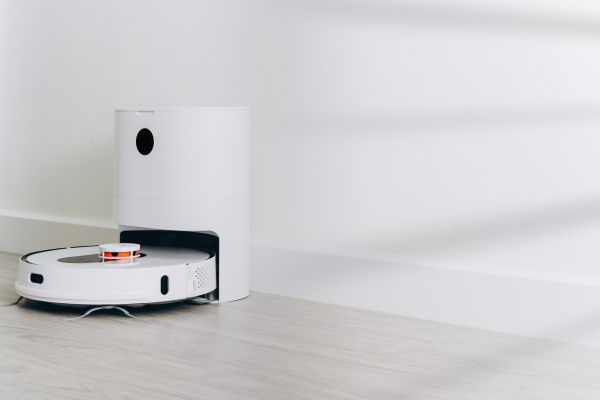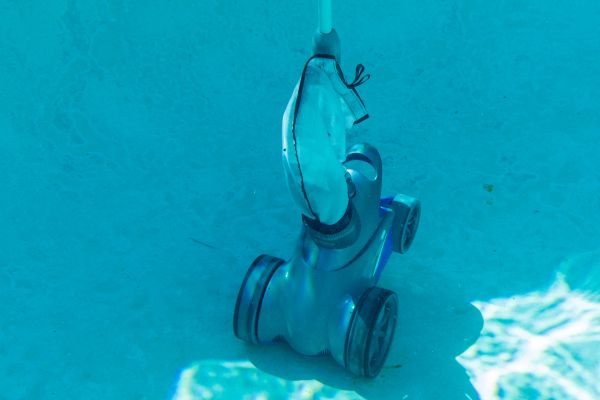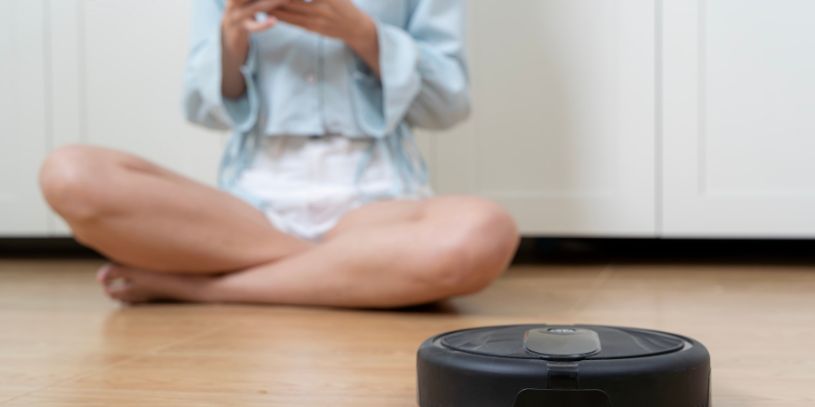Household robots for homes are transforming how people handle daily tasks. These robots handle tasks like vacuuming, mopping, lawn care, and snow removal. Certainly, they help homeowners save time and effort. Artificial Intelligence, sensors, and smart home systems have improved these robots. They work better and are easier to use. Many can map rooms, follow schedules, and empty their own dustbins. Thus, they no longer need constant supervision.
Robot Vacuums: The Household Cleaning Essential
Robot vacuums have become one of the most common household robots for homes. They provide hands-free cleaning, making them a convenient alternative to manual vacuuming. Roomba, Roborock, and Eufy make advanced robot vacuums. They have smart mapping and self-emptying docks. Indeed, users can control them with an app.
Smart mapping allows these vacuums to scan a home and create an efficient cleaning path. LiDAR, cameras, and AI-powered algorithms help them recognize obstacles and avoid unnecessary repetition. Some models let users set no-go zones so they stay away from pet bowls, stairs, or fragile furniture. Suction power depends on the model. High-end vacuums, like the Roborock S8 Pro Ultra, adjust automatically. They increase power on carpets for a deeper clean.
Battery life determines how much area a vacuum can clean on a single charge. Most models run for 90 to 180 minutes before needing to recharge. When the battery is low, they go back to the dock. They recharge and continue cleaning. Premium models empty themselves into a larger bin. This reduces how often users need to empty them. Some only need maintenance every few weeks. Many work with Alexa and Google Assistant. Likewise, users can start or schedule cleaning with voice commands.
 Robot Mops: Keeping Floors Clean with Minimal Effort
Robot Mops: Keeping Floors Clean with Minimal Effort
Robot mops offer a hands-free way to keep floors spotless. Some robots only mop. Others vacuum and mop in one device. iRobot Braava Jet, Roborock, and Ecovacs make advanced models. They use jet sprays, scrubbing pads, and water control for better cleaning.
Combo units, like the Roborock S7 MaxV, vacuum and mop in a single cycle. These robots lift their mop pads on carpets. This keeps carpets dry. Some, like the Braava Jet M6, only mop hard floors. They use smart navigation to clean every spot. Some models offer disposable or washable mop pads, giving users flexibility in maintenance. Big water tanks let robots mop longer so they need fewer refills.
These robots make floor cleaning easy, as well as save time and effort. With new technology, they are getting even smarter. Future models may clean faster, detect stains, and refill themselves.
Robotic Lawn Mowers: Effortless Lawn Maintenance
Robotic lawn mowers cut grass on a schedule. Therefore, they replace manual mowing and save time. Homeowners no longer need to push a mower or hire lawn care services. These robots for home keep yards neat with little effort.
Husqvarna Automower, Worx Landroid, and Robomow make top models. Some work best for small yards, while others handle large lawns. They can mow flat or uneven terrain. GPS and boundary wires help them navigate. They stay inside set areas and avoid obstacles like trees, fences, and flower beds.
Unlike traditional mowers, robotic models are quiet. For instance, they don’t make loud engine noises. They work anytime, even at night, without disturbing neighbors. Since they run on electricity, they don’t need gas or oil. This makes them better for the environment.
These robots sense grass height and adjust their cutting levels. They trim just a little at a time, therefore keeping the lawn even. Many models mulch the grass, returning nutrients to the soil. This helps the grass grow healthier. Some robotic mowers have rain sensors, so they stop when it’s wet and start again when the grass dries. This prevents damage and keeps blades from clogging.
Maintenance is simple. Owners only need to clean the blades and check the battery. Most models sharpen their blades automatically. Unlike gas mowers, they don’t need oil changes or fuel refills. In fact, with proper care, robotic mowers last for years.
Newer models come with smart features as well as connect to Wi-Fi or Bluetooth. Users can start, stop, or schedule mowing from a smartphone app. Indeed, some models work with Alexa and Google Assistant, allowing voice commands.
Robotic lawn mowers are becoming more popular because they make lawn care easier, save time, and reduce work. In the future, they may get even smarter. More advanced AI and better sensors will make them even more efficient.
Robot Weeders: An Eco-Friendly Solution for Gardeners
Robot weeders provide a chemical-free way to keep gardens free of unwanted plants. The Tertill is a popular weeding robot. It uses sensors to find weeds and plants. It cuts weeds at the stem before they spread, thus reducing manual weeding.
Solar-powered models work without needing to be charged manually. They patrol the garden daily, thereby identifying and eliminating weeds as they emerge. Robot weeders don’t use chemicals so they keep gardens eco-friendly. In fact, they work with little human help.
Snow Blowing Robots: Hands-Free Winter Maintenance
Shoveling snow is hard work. Snowblowing robots make it easier. Snowbot and Yarbo are top brands. These robots for homes use GPS and sensors to clear snow, so they work on driveways and sidewalks.
Battery models are quiet and eco-friendly. Gas model snow blower robots handle heavy snow better. Also, any can be controlled with a phone app. Users can clear snow while away. Lastly, safety features help them avoid cars, fences, and people.
Window Cleaning Robots for Home: Streak-Free Shine Without Effort
Cleaning large windows can be time-consuming and even dangerous, especially for high-rise buildings. Window robots like Hobot and Winbot stick to glass with suction. They move and clean without help and follow a pattern to cover the whole window. Therefore, they don’t miss spots.
Smart models use AI to find dirt. They scrub dirty areas longer. Some plug in for nonstop cleaning. Others use batteries for more flexibility. Many can be controlled with an app. Users can start and stop them remotely.
Pool Cleaning Robots: Hassle-Free Pool Maintenance
Keeping a pool clean takes work, but robotic pool cleaners do it automatically. Dolphin, Polaris, and Aiper make smart models. Likewise, they scan pools and plan the best cleaning path.
Electric models use less energy than pool pumps, so they are an efficient way to clean pools. High-end models scrub walls and tiles. In fact, they clean every surface well.
These robots for home have built-in filters to trap dirt. This helps the pool’s main filter last longer. They save time and effort. Pools stay clean with little work.
 Pet Care Robots: Automated Feeding and Playtime
Pet Care Robots: Automated Feeding and Playtime
Pet care robots help keep pets fed and entertained when owners are away. Smart feeders like PetSafe Smart Feed give food on a schedule. They control portions, so pets get the right amount. Interactive pet robots, like Ebo, move around and keep pets entertained.
Some have two-way audio and cameras. Subsequently, owners can check on pets from anywhere. Furbo and similar devices give treats on command.
Certain robots detect barking or strange behavior, then they send alerts to owners. Some advanced models use AI to read pet moods. They adjust play based on a pet’s emotions. These robots for homes improve pet care by offering convenience and reliability.
Future pet robots may track health. They could monitor eating and activity levels. This helps pets stay healthy, even when owners are away.
Smart Home Integration: Controlling Robots with AI Assistants
Many robots for home now connect with Alexa, Google Assistant, and Apple HomeKit. This makes automation easy. Users can start or schedule cleaning with voice commands. They can also adjust settings and get maintenance alerts.
A central hub can control multiple robots at once. This helps streamline daily tasks. Instead of setting up each device separately, users can manage everything in one place.
Robot vacuums, mops, and other smart devices work through smartphone apps. Users can start or pause cleaning, change schedules, or check battery levels from anywhere. These apps also give real-time updates. Some systems use geofencing, so robots start cleaning when users leave and stop when they return.
Smart home integration lets robots work together. A lawn mower can cut grass, then a vacuum can start cleaning inside. Users can set these routines to fit their needs. Some systems adjust based on the environment. If it rains, the lawn mower will pause. If pollen levels rise, an air purifier will turn on.
The Future of Household Robots for Homes
Many companies are making robots that do more than one job. Future robots for homes may vacuum, mop, and cut grass in one device. Some companies are even working on humanoid robots. These may fold laundry, cook simple meals, or unload dishwashers.
Robots for home are no longer just a cool idea. They are now a smart way to save time and effort. As AI improves, these machines will change how people manage their homes.
The goal is not just to replace chores. It is to make homes smarter and easier to run. Future robots will learn user habits. They will adjust to personal routines for a custom experience.
Automated Outdoor Solutions is Your Expert on All Things Automated
Ready to simplify your life with cutting-edge automation? Automated Outdoor Solutions is your go-to expert for all things automated. Whether you’re looking to enhance your home or business, our top-tier solutions are designed to meet your specific needs. Contact us today to discover how we can help you automate your outdoor space for convenience and efficiency. Let’s make your life easier together!

